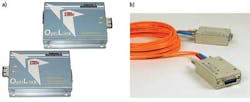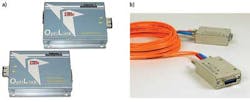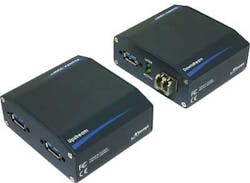Clearing Up Choices for Cabling and Connectors
Andrew Wilson, Editor
Many camera vendors now offer their products with support for various interface standards. Whether based onpoint-to-point, bus, or network protocols, each of these interface standards presents the system integrator with a plethora of price/performance tradeoffs.
For high-speed applications such as linescan-based web inspection, where high-speed point-to-point, low-latency, and highly deterministic requirements are involved, the Camera Link standard is most commonly used. In less demanding applications, slower-throughput, bus-based protocols such as USB 2.0 and FireWire can be employed.
To accommodate the next generation of high-speed cameras, the latest generation of interfaces includes point-to-point protocols such as Camera Link HS and CoaXPress (CXP); networked-based standards such as 10 Gigabit Ethernet (10GigE); and bus-based standards such as USB 3.0. Better still, the higher speeds of these camera interfaces will reduce the number of cables and connectors often required for interfacing Camera Link Full and Full Extended cameras to host computers.
As Mike Miethig, technical manager withTeledyne DALSA, points out, the scalable 300-6000 Mbytes/sec Camera Link HS interface enables multiple MDR-26 connectors and cables that may be required in traditional high-speed Camera Link systems to be replaced with a single CX4 connector (http://bit.ly/NxoYRS).
Cable length limits extended
In developing interface standards, the maximum camera-to-computer cable length (using passive cables) is often specified. In the original specifications for Camera Link, USB 2.0, and CoaXPress, these cable lengths are 10, 5, and 100 m, respectively. Although these specifications may seem to limit the applications of the cameras and computer systems that employ them, the emergence of active electrical cables, active electrical/optical cables, and active repeaters has allowed cable and peripheral manufacturers to extend these distances.
Many cable manufacturers are employing driver/equalizer chipsets that use equalization techniques to overcome the attenuation, crosstalk, and group velocity distortion effects of passive cables. As one of the first companies to recognize the advantages of employing these devices,Components Express' Bit Maxx is a Camera Link cable extender that uses pre-emphasis and equalization techniques at the camera (transmitter) side of the cable to extend camera-to-computer distances to 30 m (see "Camera Connections," Vision Systems Design, September 2010).
While Components Express has chosen to embed the ICs used to perform this pre-emphasis and equalization into a separate molded module, other proponents of active cable techniques have chosen to embed equalizers into the connector housings of the cable. PNY Technologies has taken this approach in its active 10-ft HDMI micro-cable , whereas Unibrain offers two different coaxial cables that extend FireWire 800 connectivity to 65 and 130 ft, respectively (see "Active Cables Lengthen Camera-to-Computer Connectivity," Vision Systems Design, September 2011).
Camera Link over fiber
While active electrical equalization circuitry has yet to be embedded in the connector housings of Camera Link cables, Camera Link data can be transmitted over longer distances and within environments that may be susceptible to electromagnetic interference by using fiber-optic extenders. These extenders are either offered as pairs or standalone units that convert electrical camera data and control signals to optical signals, transmit them over long distances, and then reconvert the optical data to electrical data at the frame grabber.
In 2003,Intercon 1 produced one of the first Camera Link fiber-optic extenders dubbed OptiLink. Today, a number of manufacturers including Linq Labs, Thinklogical, and Cyber Research offer similar Camera Link extenders. Ron Folkeringa, business manager of Intercon 1, points out that the technology has evolved so the hardware size of approximately 1.5 x 5 x 6.5 in. has been replaced with modules that are 75% smaller (0.5 x 1.5 x 2.5 in.; see Fig. 1). Similar extenders, now also available from companies such as EDT, can be directly attached to camera modules and frame grabbers.
Folkeringa says technology now exists that is capable of eliminating individual modules and incorporates the necessary optical transceiver within the cable assembly. This is the approach taken by Fujikura in an active optical Camera Link cable that offers fast optical data transmission beyond 10 m (see Fig. 2). A photoelectric converter is built into the MDR/SDR connector, maintaining the conventional shape. As the cable comprises both an optical fiber and an electrical wire, it is compliant with Power over Camera Link (PoCL) and operates at rates up to 85 MHz.
USB 3.0 too
Just as active and optical equalizers and repeaters are being used to extend Camera Link camera-to-computer interfaces, cable manufacturers and peripheral suppliers are taking the same approach with other interface standards such as USB 3.0. Unlike USB 2.0, where the maximum peripheral-to-computer distance is specified as 5 m, the USB 3.0 standard does not specify a standard length for such distances.
One of the first vendors to introduce a USB 3.0 camera --Point Grey -- has not tested cables longer than 4.5 m on its USB 3.0 products. To extend these distances, several different types of products are available: in-cable repeaters, active cables that implement equalization circuitry within the connector, standalone optical repeaters, and active optical cables.
Taking a similar approach to the Bit Maxx Camera Link extender, the FireNEX-uLINK USB 3.0 active repeater fromNewnex is an in-cable device that extends peripheral-to-camera lengths by up to 16 m.
Embedded in connectors
Rather than offer extenders such as in-cable repeaters, others have chosen to embed signal conditioning circuitry into the cable connectors. In 2011, Icron Technologies and Intersil introduced a USB 3.0 cable that delivers 5 Gbits/sec of throughput over 20 m. The cable embeds an Intersil QLx4600-S30 6-Gbit/sec lane extender at each end of the assembly, which extends the signal reach to more than three times the reach achievable over passive copper.
To extend this distance further, a number of external optical repeaters are available from companies such as Newnex. Its FireNEX-5000 offering consists of a pair of standalone units for electrical/optical and optical/electrical conversion of USB data that allows peripherals and computers to be interfaced at distances of approximately 100 m (see Fig. 3).
Some USB cable vendors are looking to incorporate repeaters into cable connector housings. In collaboration in 2011 with VIA Labs and DisplayLink, Avago Technologies demonstrated high-definition video streaming through a USB 3.0 active optical cable; a video demonstration can be found athttp://bit.ly/NGwpne. Then at the January 2012 Consumer Electronics show held in Las Vegas, VIA Labs announced its VO510 5-Gbit optical transceiver designed for use in USB 3.0 active optical cables for data transfers extending approximately 100 m.
According to Thomas Ryan at news outlet SemiAccurate (http://bit.ly/wjRrMC), Universal Microelectronics is producing USB cables based on the transceiver using optical fibers from Fiber Optic Communications Inc. (FOCI).
Electrical and electrical/optical active cables have long been used in the telecom and networking fields, but they have yet to find wide acceptance in machine vision. However, the attenuation, crosstalk, and group velocity distortion effects encountered using passive cables, coupled with their limited reach, will necessitate the use of active technology in future system designs to support high-resolution cameras and higher-speed interfaces.
Cable & Connector Vendors
Alysium Tech GmbH
www.alysium-tech.com
Avago Technologies
www.avagotech.com
Components Express
www.componentsexpress.com
Cyber Research
www.cyberresearch.com
DisplayLink
www.displaylink.com
EDT
www.edt.com
Fiber Optic Communications Inc. (FOCI)
www.foci.com.tw
Fujikura
www.fujikura.co.jp
Icron Technologies
www.icron.com
Intercon 1
www.intercon-1.com
Intersil
www.intersil.com
Linq Labs
www.linqlabs.com
Lynn Products
www.lynnprod.com
Newnex Technology
www.newnex.com
OCP Group
www.ocp.com
Phrontier Technologies
www.phrontier-tech.com
PNY Technologies
www.pny.com
Technical Cable Concepts
www.techcable.com
Teledyne DALSA
www.teledynedalsa.com
Thinklogical
www.thinklogical.com
Unibrain
www.unibrain.com
Universal Microelectronics
www.umec-web.net
VIA Labs
www.via-labs.com
To find more cable and connector vendors, please visit the cables and connectors section of theVision Systems Design Buyer's Guide (http://bit.ly/NlGkgt).



